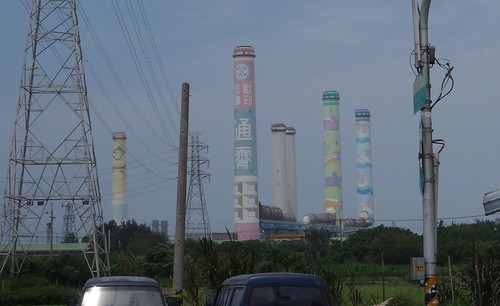I had a few minutes today so I thought I'd check out the trade figures for China pre and post ECFA, which I posted on several years ago. Then I said of the 2010-11 figures:
I had Excel put in the trend line on this quick-n-dirty chart. It's obvious even to the Mark I eyeball that the numbers for 2010 and 2011 and 2012 lie on the trend line (in fact slightly below where we would have been had the trend for 2004-07 continued). If ECFA were really that awesome what we should see is a spike after 2010, with the years 2005-2008 lying clearly below this simpleminded trend lineI spent some time today at the Bureau of Foreign Trade, which has a great database system which can be downloaded as Excel files.
First, here are the numbers for the total trade figures for China only from 2000 to 2014.
| China Only Total Ex/Im | Imports from China | Surplus/Deficit | Annual Rate of Change |
| 00 10,440,540,918 | 6,223,111,811 | -2,005,682,704 | 0.819 |
| 01 10,798,076,970 | 5,902,784,486 | -1,007,492,002 | -49.768 |
| 02 18,495,033,007 | 7,968,294,793 | 2,558,443,421 | -353.942 |
| 03 33,907,784,754 | 11,017,481,839 | 11,872,821,076 | 364.064 |
| 04 53,140,562,278 | 16,791,537,670 | 19,557,486,938 | 64.725 |
| 05 63,736,408,872 | 20,093,086,019 | 23,550,236,834 | 20.415 |
| 06 76,590,504,462 | 24,782,325,696 | 27,025,853,070 | 14.758 |
| 07 90,430,526,782 | 28,014,115,689 | 34,402,295,404 | 27.294 |
| 08 98,273,497,890 | 31,390,466,074 | 35,492,565,742 | 3.169 |
| 09 78,670,764,058 | 24,422,662,822 | 29,825,438,414 | -15.967 |
| 10 112,879,654,027 | 35,945,078,516 | 40,989,496,995 | 37.431 |
| 11 127,555,177,571 | 43,595,777,610 | 40,363,622,351 | -1.527 |
| 12 121,621,186,471 | 40,907,429,723 | 39,806,327,025 | -1.381 |
| 13 124,376,057,324 | 42,588,412,443 | 39,199,232,438 | -1.525 |
| 14 130,158,219,397 | 48,038,896,032 | 34,080,427,333 | -13.058 |
It's a bit wonky, but you can see that our trade surplus with China only has been falling. In fact it is down 13.3% again the first three months of this year. ECFA was supposed to buoy our trade with China. Just the opposite has happened since it was signed.
The data below is for the China, Hong Kong, and Macao.
China, HK, and Macao Imports Surplus/Deficit Annual Rate of Change
00 44,322,830,265 8,455,926,708 27,410,976,849 23.72
01 41,904,357,865 7,999,571,603 25,905,214,659 02 -5.493
02 53,689,295,915 9,914,356,923 33,860,582,069 04 30.71
03 67,025,011,837 12,964,443,215 41,096,125,407 21.369
04 88,696,335,831 19,133,872,975 50,428,589,881 22.709
05 100,237,776,611 22,235,386,509 55,767,003,593 10.586
06 116,139,937,773 26,688,448,674 62,763,040,425 12.545
07 130,642,313,459 29,866,598,811 70,909,115,837 12.979
08 132,890,050,715 32,912,808,344 67,064,434,027 -5.422
09 109,557,179,579 25,560,602,695 58,435,974,189 -12.866
10 152,632,897,958 37,591,908,057 77,449,081,844 32.537
11 169,546,957,259 45,290,463,268 78,966,030,723 1.959
12 162,388,783,057 43,579,102,256 75,230,578,545 -4.73
13 165,613,353,823 44,257,780,261 77,097,793,301 2.482
14 174,528,005,846 49,732,434,501 75,063,136,844 -2.639
Same general trend. Back in 2012 I noted that the trend was clearly showing a pronounced change beginning in 2010, as Fig. 1 below shows. Several things happened, among them ECFA, but also the Great Recession and the follow on austerity and other collective elite madness in Europe and the US.
Fig 1. Total trade with Hong Kong, Macao, and China. 2000-14 Data source: BFT
I just eyeballed the trend lines, so they are not exact. But they should be clear. The purple line beginning in 2010 is nowhere near as steep as the growth of the Chen Shui-bian era. If ECFA was supposed to make things boom beyond the dreams of the Chen Shui-bian era, it has been a total failure. Indeed, as the trade surplus numbers show, the surplus has fallen each year and returned to 2007 levels in 2014. In 2015 it will likely be smaller. Extrapolating from the first quarter, it will check in around $30 billion. There are many reasons for the shrinking surplus, but the numbers show that ECFA does not appear to have had any discernable effect.
It should also be obvious what will happen to the trade surplus with China if we sign that god-blighted services pact.
_______________________
[Taiwan] Don't miss the comments below! And check out my blog and its sidebars for events, links to previous posts and picture posts, and scores of links to other Taiwan blogs and forums!


2 comments:
There shouldn't be trade surpluses at all, except the cost of holding wages down. Surpluses, especially with the US, are a product of monetary policy that holds domestic wages down and forces savings rates to be high and capital to be exported.
If worker productivity is going up, ideally, domestic consumption should go up commensurately. What happens now is worker productivity goes up, wages stay the same, and the excess capital is invested abroad. One day, Taiwan will be forced to reevaluate the NT and all those great "foreign exchange reserves" will take a huge loss.
It is an investment tautology: if the Central Bank is long the US dollar (forex reserves), then it is necessarily short Taiwan. Let that sink in for a second. Yep, the bank bets against the average wage earner and aids domestic investors (財團). Is this really the tradeoff you want or Taiwanese people would want if they were made aware of it?
The conclusion is clear -- KMT suck, they are not bad guys, but they suck.
Post a Comment